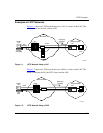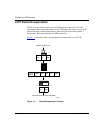
Configuring L2TP Services
1-2
303532-A Rev 00
L2TP Benefits
L2TP has several advantages:
• Users and businesses can take advantage of existing network equipment and
resources.
Corporations do not need to maintain and manage remote access servers and
other special networking equipment for remote users. Instead, they can use
their existing Internet leased connections and resources at the Internet Service
Provider (ISP) network, thereby significantly reducing corporate networking
and maintenance costs.
In addition, corporations do not need to provide technical support to the
remote users. Because the remote user is making a local call to the ISP, the
ISP provides technical assistance if the user has trouble making connections.
• Remote users can place a free local call to their ISP for access to the Internet,
eliminating long-distance toll calls required to dial the corporate network
directly.
• ISPs earn more business from corporate customers using the equipment,
thereby increasing the ISP’s revenues.
• L2TP is a standards-based protocol that provides greater interoperability with
networking equipment from other vendors.
What Is Tunneling?
Tunneling is a way of forwarding traffic from remote users to a corporate network
through an IP network. A tunnel is a virtual connection between two sites, for
example, an access concentrator at the ISP network and a router at the corporate
network. Tunneling across an existing public network such as the Internet creates
a virtual private network that offers corporate network access to a wider range of
remote users.
L2TP is a tunneling mechanism that extends the end point of the Point-to-Point
Protocol (PPP) connection from an L2TP access concentrator (LAC) or remote
access server (RAS) at the ISP network to an L2TP network server (LNS) at the
corporate site.


















